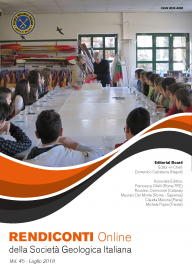
Heavy minerals distribution and provenance in modern beach sands of Campania, Italy
Emilia Le Pera (a) & Consuele Morrone (a)
(a) Dipartimento di Biologia, Ecologia e Scienze della Terra (DiBEST) - Università della Calabria, 87036 Arcavacata di Rende (CS), Italy.
Corresponding author e-mail: emilia.lepera@unical.it
Volume: 45/2018
Pages: 136-140
Abstract
The Campania region (southern Italy) is an excellent area to determine the effects of multiple source lithology (volcanic+sedimentary), climate, weathering, transport and
depositional environment on heavy minerals enrichments in the sandy beaches of the coastline between Pozzuoli and Bacoli, and at the Volturno river-mouth. The heavy mineral (HM) assemblage should reflect the clastic supply from the potassic to ultrapotassic lavas and pyroclastic rocks of the Campania and of the Roman Magmatic provinces (Phlegrean Fields, Roccamonfina volcano), and from the recycling of sedimentary - both carbonate and siliciclastic - terranes of the Apennine thrust belt. Opaque oxides, pyroxene and amphibole assemblage dominates in the beach placers of the Campania shoreline - from Bacoli to Pozzuoli - as well as in the Volturno river mouth sands to the north. Modern heavy minerals assemblages reflect clastic contribution from magmatic source rocks whereas contribution
from sedimentary terranes - exposed extensively in the Volturno river drainage - provide no recycled heavy minerals to the river-mouth sand. Thus, heavy minerals linked to a provenance from the Apennine thrust belt source rocks result diluted and/or unrecognizable using the only HM approach with respect to the minerals provenance sourced by the potassic volcanic fields of Latium and Campania. The
diverse detrital heavy minerals have been characterized describing major stages of progressive chemical weathering, from unweathered to corroded to etched morphologies, a process - in this case-history - playing a minor role in reducing HM diversity through dissolution of moderately stable mineral species.
Keywords
Get Full Text